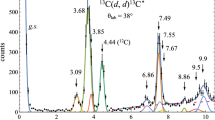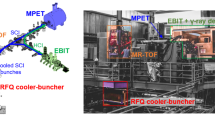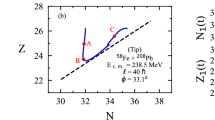Abstract
Total cross sections for single and double electron capture in collisions of bare ion with helium-like atoms are calculated at energies ranging from 50 to 6,000 keV/amu. The present calculations are carried out using four-body formalism of Coulomb–Born distorted wave formalism and boundary corrected continuum intermediate state approximation. We have made a comparison between single and double electron capture cross sections using both the methods in wide range of energies at different charge state of the projectile. Total cross sections have been calculated by summing over all the contributions up to n = 2 shells and sub-shells. It is also noted that double electron capture cross sections are small thorough out the energy region compared with the single electron capture cross sections. However, the present computed results for asymmetric collisions have been compared with available theoretical and experimental results. We find that our numerical results for total cross sections show good agreement with the available experimental findings.





Similar content being viewed by others
References
R K Janev Atomic and Molecular Processes in Fusion Edge Plasmas (New York: Plenum) (1995)
I Murakami, J Yan, H Sato, M Kimura, R K. Janev and T Kato At. Data Nucl. Data Tables 94 161 (2008)
M Ghosh, C R Mandal and S C Mukherjee J. Phys. B At. Mol. Phys. 18 3797 (1985)
R E Olson J. Phys. B At. Mol. Phys. 15 L163 (1982)
Dz Belkic J. Phys. B At. Mol. Opt. Phys. 26 497 (1993)
Dz Belkic Phys. Rev. A 47 189 (1993)
Dz Belkic Phys. Rev. A 47 3824 (1993)
Dz Belkic, I Mancev and M Mudrinic Phys. Rev. A 49 3646 (1994)
Dz Belkic Nucl. Instrum. Methods Phys. Res. B 62 86 (1994)
Dz Belkic, R Gayet, J Hanssen, I Mancev and A Nunez Phys. Rev. A 56 3675 (1997)
I Mancev, N Milojevic and Dz Belkic Phys. Rev. A 88 052706 (2013)
I Ben-Itzhak, A Jain and O L Weaver J. Phys. B At. Mol. Opt. Phys. 26 1711 (1993)
H F Busnengo, A E Martinez and R D Rivarola J. Phys. B At. Mol. Opt. Phys. 29 4193 (1996)
R Gayet, J Hanssen, L Jacqui, A Martinez and R Rivarola Phys. Scr. 53 549 (1996)
Dz Belkic, I Mancev and J Hanssen Rev. Mod. Phys. 80 249 (2008)
M Purkait Eur. Phys. J. D 30 11 (2004)
S Ghosh, A Dhara, M Purkait and C R Mandal Indian J. Phys. 84 231 (2010)
S Ghosh, A Dhara, C R Mandal and M Purkait Phys. Rev. A 78 042708 (2008)
R Samanta, M Purkait and C R. Mandal Phys. Rev. A 83 032706 (2011)
R Samanta, S Jana, S Ghosh, M Purkait and C R Mandal Indian J. Phys. 86 503 (2012)
S Jana and M Purkait Indian J. Phys. 88 343 (2014)
B Ding Phys. Scr. 85 015302 (2012)
N Bohr, L Lindhard and K Dan Vidensk Selsk. Mat. Fys. Medd 28 7 (1954)
M B Shah and H B Gilbody J. Phys. B 18 899 (1985)
O Woitke, P A Zavodszky, S M Ferguson, J H Houck and J A Tanis Phys. Rev. A 57 2692 (1998)
M M Sant’ Anna et al. Phys. Rev. A 80 042707 (2009)
W S Melo et al. Phys. Rev. A 60 1124 (1999)
R Hippler, S Datz, P D Miller, P L Pepmiller and P F Dittner Phys. Rev. A 35 585 (1987)
T R Dillingham, J R Macdonald and Patrick Richard Phys. Rev. A 24 1237 (1981)
J A Guffey, L D Ellsworth and J R Macdonald Phys. Rev. A 15 1963 (1977)
M Sasao et al. J. Phys. Soc. Jpn. 55 102 (1986)
R W McCullogh, T V Goffe, M B Shah, M Lennon and H B Gilbody J. Phys. B At. Mol. Opt. Phys. 15 111 (1982)
M B Shah, D S Elliott and H B Gilbody J. Phys. B At. Mol. Opt. Phys. 18 4245 (1985)
R D DuBois and L H Toburen Phys. Rev. A 31 3603 (1985)
P Lowdin Phys. Rev. 90 120 (1953)
R Gayet, J Hanssen, A Martinez and R Rivarola Nucl. Instrum. Methods Phys. Res. B 86 158 (1994)
R R Lewis Phys. Rev. A 14 1009 (1956)
I Mancev Phys. Rev. A 64 012708 (2001)
Y D Wang, N Toshima and C D Lin Phys. Scr. T62 63 (1996)
D Brandt Nucl. Instrum. Methods 214 93 (1983)
Dz Belkic Phys. Scr. 40 610 (1989)
J Eichler Phys. Rev. A 23 498 (1981)
V S Nikolaev, I S Dmitriev, L N Fateeva and Yu A Teplova, Sov. Phys. JETP 13 695 (1961)
J R Macdonald and F W Martin Phys. Rev. A 4 1965 (1971)
Acknowledgments
The author would like to express his gratitude to Professor C R Mandal for helpful discussions and a critical review of the manuscript. We gratefully acknowledge financial support from the Council of Scientific and Industrial Research (CSIR), New Delhi, India, under project number 03/1184/10/EMR-II.
Author information
Authors and Affiliations
Corresponding author
Appendix
Appendix
Here A, B, C and D in Eq. (13) of the main text are given by
where
The term Q1 and Q2 can be explicitly written as
Rights and permissions
About this article
Cite this article
Jana, S., Purkait, M. Comparative study of single and double electron capture from atoms by fast bare ions. Indian J Phys 89, 641–647 (2015). https://doi.org/10.1007/s12648-014-0638-8
Received:
Accepted:
Published:
Issue Date:
DOI: https://doi.org/10.1007/s12648-014-0638-8




